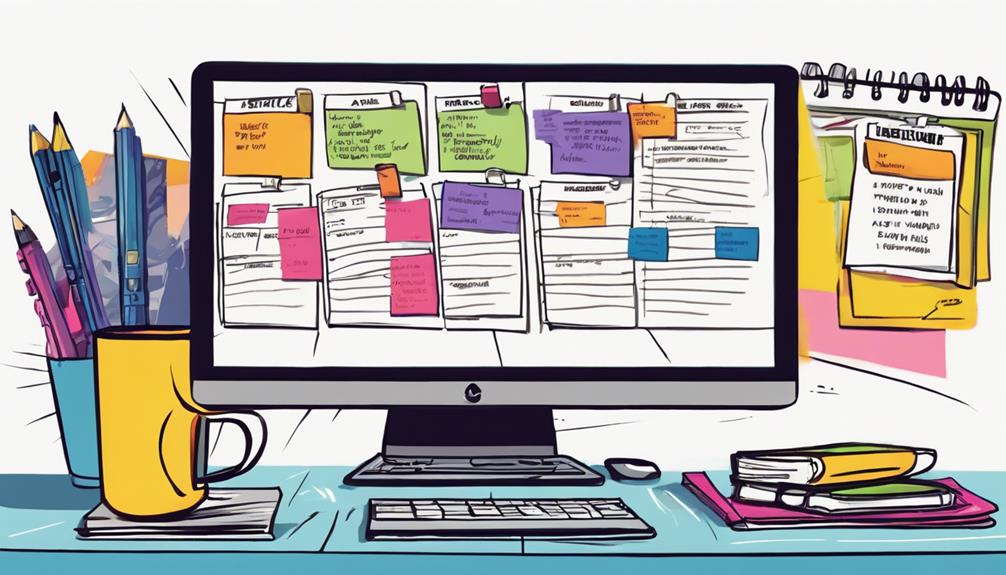To get started with your first webinar, begin by establishing clear objectives that resonate with your audience. Select a suitable platform based on features and your budget, and choose the best timing – midweek is optimal. Develop engaging content with interactive elements to maintain participant interest. Ensure your technical setup is reliable by testing equipment beforehand. Effectively promote through email and social media while involving attendees with polls and Q&A sessions. Remember to follow up afterwards with thank-you emails and feedback requests. By following these steps, you are well on your way to a successful webinar, with plenty more to discover.
Key Takeaways
- Define clear objectives to connect with your audience and measure success effectively.
- Choose a webinar platform that fits your needs, considering features, costs, and audience engagement tools.
- Schedule your webinar midweek around 11 a.m. to optimize attendance and engagement.
- Plan interactive and visually appealing content, ensuring a logical flow and a duration of 30-60 minutes.
Define Your Objectives
Defining clear objectives for your webinar is essential, as it shapes your content and helps you connect with your target audience. Start by articulating the purpose of your webinar—are you aiming to educate, generate leads, or build brand awareness? This clarity will guide both your content creation and the selection of your target audience.
Next, plunge into understanding who your target audience is. Analyze their demographics, interests, and pain points to guarantee your objectives align with their needs and expectations. For instance, if your goal is to educate, consider what information would be most beneficial to your audience.
Establish specific, measurable outcomes for your webinar. Think about how many attendees you want, engagement rates, or desired follow-up actions. These metrics will allow you to evaluate the success of your objectives effectively.
Lastly, incorporate key takeaways that participants should leave with, enhancing their experience while providing tangible value. Regularly review and adjust your objectives based on feedback from past webinars; this guarantees continuous improvement and maintains relevance with your audience.
Choose a Webinar Platform

When choosing a webinar platform, you'll want to compare features and costs to find the best fit for your needs.
Consider what limitations each platform has, especially regarding audience size and engagement tools.
This way, you can guarantee a seamless experience for both you and your attendees.
Platform Features Comparison
Choosing the right webinar platform hinges on key features that boost audience engagement and streamline your process. You'll want a platform that not only meets your needs but also enhances the experience for your attendees.
Consider these essential features:
- Live chat: Enables real-time interaction, making your presentation more engaging.
- Q&A options: Allows audience members to ask questions, fostering a participatory atmosphere.
- Interactive polls: Boosts attendance by keeping your audience involved and interested.
- Mobile access: Supports viewers who prefer joining via smartphones or tablets, catering to a larger audience.
Cost Vs. Limitations
Evaluating the cost of a webinar platform alongside its limitations is essential for finding the right fit for your needs and budget. Many platforms use tiered pricing, which can impact what features you access based on your investment. Free platforms might seem appealing initially, but they often come with significant limitations like attendee caps and fewer interactive options.
To help you make an informed choice, consider the following comparison:
| Platform Type | Key Features |
|---|---|
| Free | Limited attendees, no branding, basic support |
| Paid | Higher attendee limits, custom branding, advanced analytics |
Paid platforms like Zoom and GoToWebinar typically offer greater functionality, which can enhance your professional presentations. However, remember to factor in additional costs for features like extra storage or technical support, as these can escalate your overall expense. Finally, take advantage of free trials to evaluate the user interface, ensuring it's intuitive for both you and your attendees. Balancing cost and limitations will guide you toward a platform that suits your specific needs.
Select Optimal Timing

When you're planning your webinar, it's vital to take into account when your audience is most available.
Think about their time zones and peak activity times to guarantee you maximize attendance.
Audience Availability Considerations
Finding the right timing for your webinar can greatly boost attendance, so consider scheduling it midweek, ideally on a Tuesday to Thursday. These days are typically less hectic for most professionals, increasing the likelihood that your audience will be available. Aim for around 11 a.m. in your attendees' local time zones, as this is when they're generally settled into their workday.
To optimize audience availability, keep these tips in mind:
- Analyze website traffic data for peak days and times.
- Consider lunch hours or just after work hours for scheduling.
- Factor in different time zones to reach a broader audience.
- Avoid Mondays and Fridays, as they can be busy or disengaging.
Time Zone Coordination
To guarantee maximum participation, it's essential to analyze your audience's geographical locations and select a time that aligns with their convenience. Start by utilizing tools like World Time Buddy or Time Zone Converter to visualize and compare different time zones. This will help you determine the best timing for your webinar.
Scheduling your event midweek, preferably between Tuesday and Thursday at 11 a.m. in your primary audience's time zone, often yields higher attendance rates. If your audience spans multiple time zones, consider hosting several sessions at different times to cater to various regions. This approach enhances engagement and guarantees that more participants can join in.
When you promote your webinar, clearly communicate the time zone. Use a consistent reference, like '11 a.m. EST,' and include a link to a time zone converter in your promotional materials. This clarity will reduce confusion and show respect for your audience's time.
Plan Your Content

Outlining a clear structure for your webinar content helps create a logical flow that keeps your audience engaged. Start by identifying your main topics and subtopics, making certain they address your audience's specific challenges and interests. This approach is essential for any content marketing strategy, especially when promoting your webinar on social media.
To enhance your presentation, consider the following:
- Interactive elements: Integrate polls and Q&A segments every 4-5 slides to encourage participation.
- Visual aids: Limit text on slides to key points and use high-quality images and graphics to boost understanding.
- Timing: Aim for a duration of 30-60 minutes to match audience attention spans.
- Feedback incorporation: Use research and analytics to tailor your content to what your audience truly wants.
Ensure Technical Setup

Ensuring your technical setup is flawless is essential for delivering a smooth and engaging webinar experience. Start by testing your audio and video equipment at least one week prior to the event. This allows you to confirm clear communication and eliminate potential disruptions. Familiarize yourself with your chosen webinar platform's features, like screen sharing and polling options, to enhance audience interaction.
A stable internet connection is imperative. Whenever possible, use a wired connection instead of relying on Wi-Fi, which can be unreliable during live presentations. Additionally, prepare backup equipment, such as an alternative device and an internet source like a mobile hotspot, so you're ready for any technical failures.
Conducting a dry run with all speakers at least 48 hours before the event is essential. This practice session helps you identify any issues and streamline the presentation flow, ensuring everyone is comfortable with the technical setup.
Prepare Your Speakers

To guarantee your webinar's success, choose speakers with both expertise and strong presentation skills.
You'll also need to provide them with training on the platform and schedule rehearsals to polish their delivery.
This preparation will help align their content with your webinar objectives and keep the audience engaged.
Speaker Selection Criteria
Selecting the right speakers for your webinar is crucial, as their expertise and presentation skills will greatly impact audience engagement and overall success. Here are some criteria to take into account during your speaker selection process:
- Relevant Expertise: Choose speakers with a proven track record in the subject matter to establish credibility.
- Presentation Skills: Evaluate their ability to engage an audience by reviewing previous videos or presentations.
- Diversity: Incorporate a range of perspectives to enrich the content and appeal to a broader audience.
- Audience Engagement Strategies: Provide guidelines on interactive elements like polls or Q&A sessions to foster participation.
Training and Rehearsals
How can you effectively prepare your speakers for a successful webinar experience?
Start by selecting knowledgeable and engaging presenters who can connect with your audience.
Schedule rehearsal sessions for your speakers to practice using the webinar platform. This step guarantees they're comfortable with essential features like screen sharing and chat functionalities.
During these practice runs, encourage your speakers to engage with the audience, allowing them to refine their delivery and timing.
Use feedback from these sessions to identify areas for improvement—focus on pacing, clarity, and techniques to boost audience engagement.
Don't forget to conduct technical dry runs, where you test audio and video equipment. This guarantees everything runs smoothly on the big day.
By combining rehearsal sessions with technical dry runs, your speakers will feel more confident and prepared, leading to a more polished and professional presentation.
Ultimately, investing time in training and rehearsals sets the stage for a successful webinar, fostering a comfortable environment for both your speakers and audience.
With the right preparation, you'll create an engaging and impactful experience that resonates with everyone involved.
Promote Effectively

Promoting your webinar effectively starts with building anticipation at least two weeks in advance, ensuring you reach the widest audience possible. To engage your potential attendees, follow these best practices:
- Use email marketing: Send out initial invitations and follow-up emails to keep your audience informed.
- Create a dedicated landing page: Clearly outline your webinar's details, benefits, and include a simple sign-up form.
- Leverage social media: Share engaging graphics and countdown reminders to create buzz around your event.
- Send reminders: Keep your audience engaged by sending emails at two weeks, one week, and one day before the event.
Engage Attendees

Engaging attendees during your webinar is essential for creating a memorable experience and fostering meaningful interactions. Start with a enthralling introduction that draws your audience in and sets an inviting tone. Use storytelling techniques to connect emotionally, making your content relatable and impactful.
Incorporate interactive elements like polls and Q&A sessions every 4-5 slides. This real-time participation keeps the energy up and allows you to engage attendees actively. Allocate time for audience questions at the end, which not only fosters interaction but also shows that you value their input.
Monitor engagement levels throughout the session. Utilize live chats to acknowledge attendee contributions, encouraging dialogue and making participants feel seen. This interaction can greatly boost their investment in your presentation.
Lastly, enhance understanding by implementing multimedia elements, such as high-quality visuals and videos. These tools can keep your audience's attention and make complex ideas more digestible.
Follow Up After

Following up after your webinar is essential for maintaining momentum and reinforcing the connections you've made with your attendees. To maximize the impact of your follow-up, aim to send out emails within 24 hours. This keeps the experience fresh in their minds and shows your commitment.
Here are some key elements to include in your follow-up:
- Thank attendees for their participation and provide access to the webinar recording.
- Include a feedback survey to gather insights on attendee satisfaction and areas for improvement.
- Share additional resources or downloadable content related to the webinar topic to enhance their learning experience.
- Encourage attendees to engage on social media by sharing their thoughts or highlights from the webinar, using a dedicated hashtag.
Analyze Performance

To effectively measure your webinar's success, explore in-platform metrics like attendance rates and engagement levels. Analyzing performance is essential for understanding how well your content resonated with participants. Start by tracking key performance indicators (KPIs) such as registration numbers and drop-off points during the presentation. These metrics will help you gauge where you lost audience interest and where you excelled.
Don't forget to gather participant feedback through post-webinar surveys. This data provides valuable insights into what worked well and what could improve. Additionally, utilize analytics tools to assess the effectiveness of your promotional efforts. By monitoring registration sources and attendee demographics, you can refine your targeting for future webinars.
Compile a detailed report summarizing these outcomes, highlighting strengths and areas for improvement. Comparing your performance against industry benchmarks can also reveal gaps in execution and presentation style. By systematically analyzing these metrics, you'll be better equipped to enhance your strategy for subsequent webinars, ensuring your content remains engaging and relevant.
Will Setting Up a Webinar Help With Recording it?
Setting up a webinar can greatly benefit from following stepbystep webinar recording instructions. By adhering to a systematic approach, the recording process becomes more efficient and organized. This ensures that the webinar content is captured accurately and with high quality, resulting in a more polished final product.
Conclusion
With these expert tips in your toolkit, you're ready to launch your first webinar like a pro.
Picture your audience hanging on your every word, captivated by your content and enthusiastic to engage.
By defining clear objectives and promoting effectively, you're laying the foundation for success.
So, step into the spotlight, share your knowledge, and watch your virtual stage come alive.
Remember, every great journey begins with a single step—let this be yours!









